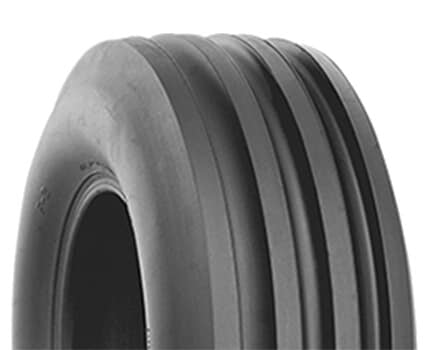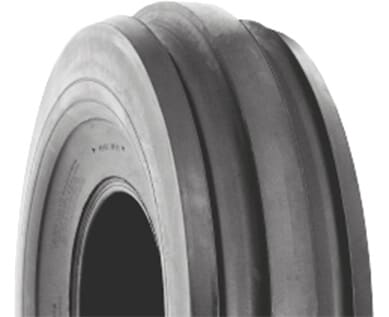Choosing The Best Front Tire for Your Operation

The front steer tires on your 2WD tractor carry the load of the front axle and generates the lateral force to steer your tractor in soils and on pavements. Since these tires are free rolling, the tread pattern is what develops the force needed to steer the tractor. To generate enough force, 2WD steer tires typically have a deep rib pattern to engage the soil or paved surfaces.
When looking for front steer tires it is important to understand what the tractor’s normal tasks will be and understand which rib configurations are ideal for those tasks.
Rib Options for Front Tractor Tires
Single Rib – This pattern was designed for tractor that primarily operate in loose or wet/muddy soil conditions. The tall single rib develops excellent force when steering and there are no grooves to fill up with mud. With the single rib, it does wear out faster on paved surfaces because all the weight is being carried on the tall rib.
Three Rib – This pattern was designed for tractors that operate in a mixture of loose soils and paved surface. The taller center rib develops the force when steering in loose soil and the outside ribs help carry the load when operating on paved surfaces.This tread pattern is an excellent choice for most 2WD tractors without front-end loaders.
Four Rib – This pattern was designed for tractors that operate in a mixture of loose soils and paved surfaces and have a front-end loader. The four ribs develop the force when steering in soils and on paved surfaces while the constant rib height provide an even load distribution on hard surfaces. This even load distribution contributes to longer tire life on hard surfaces especially when used on tractors with front-end loaders. It should be noted with any loader application be sure to check the load capacity of the tire and compare with the front axle load of the tractor in combination with the loader and a full loader bucket.
Shallow Five Ribs – This pattern was designed for tractor and backhoes that operate mainly on paved surface and have a front-end loader. Operating on paved surfaces requires less rib height to prove a steer force and the larger number of ribs allow for a greater load distribution.

Single Rib Front Tractor Tires
The single rib or mono tractor tire (F-1) provides steering control and soil traction. It has a smooth surface with one prominent rib in the center and is specially designed for deep mud conditions, such as in cane and rice fields.

Four Rib Front Tractor Tires
The CHAMPION GUIDE GRIP 4-RIB (F-2M) tractor tire is designed for great hold, high flotation and resistance to side slip while carrying heavy loads on hard-packed surfaces. This type of tire will provide strong steering in the field with quality load distribution and floatation.

Three Rib Front Tractor Tires
The CHAMPION GUIDE GRIP 3-RIB (F-2) tractor tire is best for greater lateral traction. The three ribs impact the cornering, turning, and directional response of the tractor when changing direction and sustaining lateral acceleration. This proves most important when you are dealing with uneven land or steep inclines. This three-rib design affects the overall handling and the driver’s ability to maintain control.

Rib Duplex Farm Tire
The RIB DUPLEX FARM TIRE (I-1) is known for its wide-rib tread for excellent floatation characteristics. This tire has a less obvious non-directional tread design than the duo rib tire and is used for exceptional steering ease and high floatation on front wheel positions.
Proper Inflation for your Front Tractor Tires
Correct tire pressure for the load and speed can vary, but the FIRESTONE AG TIRE INFLATION CALCULATOR can provide the information that you are looking for. The calculator allows you to select your application, including tractor, sprayer, harvest combine, grain cart, or implements. Next you will input axel position and tire configuration to help the calculator understand how your equipment is set up. Lastly, enter in your tire size and axel load and select “Calculate” to see the correct PSI for your equipment. A handy tool to have in your toolbox, Firestone recommends bookmarking it on your phone or computer.
Between the size, rib, ply, and other choices to consider, picking the right tire can seem overwhelming, and get in the way of keeping your farm running as efficiently and effectively as possible. For help on your purchase decision or guidance on selecting the correct tire for the job, contact your local Firestone Ag Certified Dealer.
